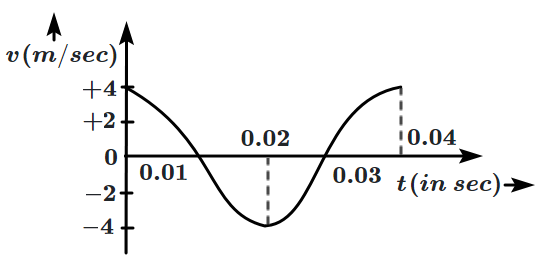An ideal spring with spring-constant K is hung from the ceiling and a block of mass M is attached to its lower end. The mass is released with the spring initially un-stretched. Then the maximum extension in the spring will be:
1. 4 Mg/K
2. 2 Mg/K
3. Mg/K
4. Mg/2K
1. 4 Mg/K
2. 2 Mg/K
3. Mg/K
4. Mg/2K
The velocity-time diagram of a harmonic oscillator is shown in the figure given below. The frequency of oscillation will be:
1. 25 Hz
2. 50 Hz
3. 12.25 Hz
4. 33.3 Hz
The variation of the potential energy of the harmonic oscillator is shown in the figure. The spring constant will be:

| 1. | 1 × 102 N/m | 2. | 150 N/m |
| 3. | 0.667 × 102 N/m | 4. | 3 × 102 N/m |
A particle moves according to the law, . The distance covered by it in the time interval between t =0 to t =3 s will be:
| 1. | r | 2. | 2r |
| 3. | 3r | 4. | 4r |
A mass of 30 g is attached with two springs having spring constant 100 N/m and 200 N/m and other ends of springs are attached to rigid walls as shown in the given figure. The angular frequency of oscillation will be
1.
2.
3. 100 rad/s
4. 200 rad/s
If a particle in SHM has a time period of \(0.1\) s and an amplitude of \(6\) cm, then its maximum velocity will be:
1. \(120 \pi\) cm/s
2. \(0.6 \pi\) cm/s
3. \(\pi\) cm/s
4. \(6\) cm/s
If the potential energy U (in J) of a body executing SHM is given by U = 20 + 10 (100t), then the minimum potential energy of the body will be:
| 1. | Zero | 2. | 30 J |
| 3. | 20 J | 4. | 40 J |
The kinetic energy (K) of a simple harmonic oscillator varies with displacement (x) as shown. The period of the oscillation will be: (mass of oscillator is 1 kg)

| 1. | sec | 2. | sec |
| 3. | sec | 4. | 1 sec |
The equation of an SHM is given as y=3sinωt + 4cosωt where y is in centimeters. The amplitude of the SHM will be?
| 1. | 3 cm | 2. | 3.5 cm |
| 3. | 4 cm | 4. | 5 cm |
The time periods for the figures (a) and (b) are respectively. If all surfaces shown below are smooth, then the ratio will be:
1. 1:
2. 1: 1
3. 2: 1
4. : 2





